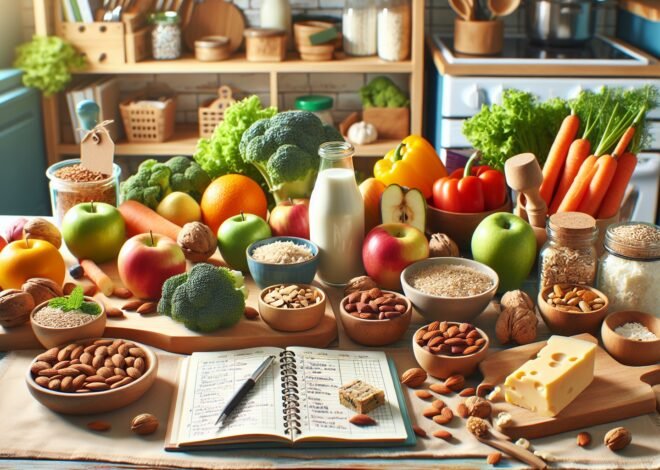
The Myth of “Negative-Calorie Foods”: What Science Says
The negative-calorie foods myth suggests that certain foods consume more energy during digestion than they provide, leading to weight loss; however, science largely debunks this. While the appeal of effortlessly burning calories is tempting, scientific studies reveal it as more fiction than fact. This post explores the truths and misconceptions surrounding negative-calorie foods, examining why this myth persists and what it truly means for your diet. Inform yourself on how bodies process food and what genuinely influences calorie consumption. Discover why relying on these foods for weight loss may be misleading, urging you to focus on a balanced diet instead.
Understanding the Concept of Negative-Calorie Foods
Negative-calorie foods are often touted as a quick fix for weight loss. The idea is simple: consume foods that require more energy to digest than they provide. While this concept sounds appealing, it’s crucial to examine its origins and scientific validity. This section delves into the myth’s history, the foods often associated with it, and the truth about caloric burning through digestion.
Origins and Popularity of the Negative-Calorie Food Myth
The negative-calorie food myth has intrigued dieters for decades. It suggests that certain foods cause you to burn more calories than they contain. This myth likely gained traction in the 1970s when low-calorie diets became fashionable. The allure of eating without gaining weight is undeniably strong, making this concept a popular topic in diet culture.
Curiously, the myth often connects to foods like celery, grapefruit, and lettuce. These foods are low in calories and high in water content, lending credibility to the idea that they might burn more calories during digestion. However, while they are low in calories, the notion that they create a calorie deficit on their own is misleading.
Over the years, the myth’s popularity has persisted, fueled by anecdotal evidence and pseudo-scientific claims. Diet books and online articles often perpetuate these claims without substantial scientific backing. This has led to widespread belief in negative-calorie foods, despite a lack of supporting evidence.
Commonly Believed Negative-Calorie Foods
Several foods are commonly believed to have negative calories. These include celery, cucumber, and broccoli, among others. These foods are low-calorie, high-fiber, and nutrient-dense, making them staples in many diets. However, it’s essential to understand they don’t inherently result in a calorie deficit.
- Celery: Often cited due to its high water and fiber content.
- Cucumber: Similar to celery, it’s low in calories and refreshing.
- Broccoli: Packed with nutrients, yet low in calories.
- Lettuce: Another low-calorie, high-water vegetable.
- Grapefruit: Known for its tart flavor and low-calorie content.
Despite these foods being healthy, they are not magical calorie burners. They are beneficial for weight loss when part of a balanced diet, but relying on them for negative-calorie effects can lead to disappointment.
Caloric Burning through Digestion: Fact or Fiction
The idea that digestion burns more calories than the food itself provides is compelling. The energy required to digest food is known as the thermic effect of food (TEF). TEF accounts for about 5-10% of your daily caloric expenditure, depending on your diet’s composition.
However, the notion that specific foods cause a caloric deficit through digestion isn’t supported by science. While some foods might have a slightly higher TEF, the difference is negligible. The body efficiently extracts energy from food, even from low-calorie options.
The myth persists due to a misunderstanding of how digestion works. Digestion is a complex process, but it’s not enough to tip the scales toward negative calories. Instead, focusing on a varied diet rich in nutrient-dense foods is a more effective strategy for health and weight management.
Scientific Analysis of Negative-Calorie Claims
To truly understand negative-calorie foods, a scientific lens is essential. This section explores the thermic effect of food, metabolic processes, and expert opinions to debunk the myth. By analyzing these factors, we can discern fact from fiction and guide healthier dietary choices.
Thermic Effect of Food: What the Research Reveals
The thermic effect of food (TEF) is the calorie-burning process during digestion, absorption, and metabolization. Research reveals that TEF varies based on macronutrient composition. Proteins have the highest TEF, followed by carbohydrates, then fats.
Studies indicate that TEF accounts for about 10% of total calorie consumption. This means if you consume 2,000 calories daily, around 200 calories are expended through digestion. This process plays a minor role in total energy expenditure and does not support the negative-calorie claims associated with certain foods.
Foods like celery or cucumber, which are often labeled negative-calorie, have minimal TEF due to their low caloric content. The calories burned digesting them do not exceed the calories they provide. Therefore, the negative-calorie concept remains unsubstantiated by scientific evidence.
Metabolic Processes and Energy Expenditure
Metabolism encompasses all chemical processes occurring within the body to maintain life. Energy expenditure occurs in three main ways: basal metabolic rate (BMR), physical activity, and the thermic effect of food (TEF). BMR accounts for the majority of energy expenditure, followed by physical activity, and finally, TEF.
Metabolic processes are influenced by factors including age, sex, muscle mass, and hormonal balance. While TEF contributes to energy expenditure, its impact is relatively minor compared to BMR and physical activity. The notion that eating specific foods can significantly boost metabolism or result in a net calorie loss isn’t supported by current scientific understanding.
Instead, a well-rounded approach to weight management involves increasing physical activity and supporting metabolic health through a balanced diet. These strategies are more effective than relying on the negative-calorie food myth.
Expert Opinions on Negative-Calorie Diets
Experts in nutrition and dietetics often dismiss negative-calorie diets as a fad lacking scientific credibility. Registered dietitians emphasize the importance of balanced, nutrient-dense diets over quick-fix solutions. They caution against overly restrictive diets based on unproven claims.
Research-backed dietary approaches prioritize variety, moderation, and sustainability. Experts advocate for incorporating all food groups to meet nutritional needs and support overall health. The negative-calorie narrative detracts from the more critical aspects of healthy eating.
Ultimately, expert opinions align with scientific evidence, suggesting that focusing on nutrient-rich foods and a balanced lifestyle is more beneficial than chasing dietary myths. Proper guidance from health professionals ensures a healthy approach to weight management and overall well-being.
Practical Diet Tips Beyond the Negative-Calorie Myth
Moving beyond myths involves adopting practical dietary habits that promote health and well-being. This section offers actionable tips for incorporating nutrient-dense foods, balancing diet with activity, and adopting sustainable weight management strategies. These approaches ensure long-term success and dietary satisfaction.
Incorporating Nutrient-Dense Foods for Weight Loss
Nutrient-dense foods are rich in vitamins, minerals, and other beneficial compounds, but low in calories. Including these foods in your diet supports weight loss by providing essential nutrients without excess energy intake.
Here are some nutrient-dense foods to consider:
- Leafy greens: Spinach, kale, and Swiss chard are packed with nutrients.
- Berries: Blueberries, strawberries, and raspberries offer antioxidants.
- Lean proteins: Chicken, turkey, and legumes support muscle health.
- Nuts and seeds: Almonds, chia seeds, and flaxseeds provide healthy fats.
- Whole grains: Quinoa, brown rice, and oats are high in fiber.
These foods contribute to a sense of fullness and can help manage cravings. Incorporating them into meals and snacks maintains energy levels and supports metabolism.
Balancing a Healthy Diet with Physical Activity
Diet and exercise are complementary components of a healthy lifestyle. A balanced diet provides the fuel needed for physical activity, which in turn supports weight management and cardiovascular health.
Consider the following tips to balance diet and exercise:
- Set realistic goals for both diet and physical activity.
- Include a mix of cardio, strength, and flexibility exercises.
- Ensure meals are timed to support workout energy and recovery.
- Stay hydrated before, during, and after exercise.
- Listen to your body’s hunger and fullness cues.
Finding enjoyable activities encourages consistency. Combining these practices ensures comprehensive health and supports weight management goals.
Realistic Approaches to Sustainable Weight Management
Sustainable weight management involves strategies that are practical and maintainable long-term. Short-term diets often result in temporary results, while gradual lifestyle changes yield lasting benefits.
Here are some realistic approaches to consider:
- Set achievable goals and track progress.
- Practice mindful eating and savor each meal.
- Make gradual dietary changes rather than drastic shifts.
- Focus on portion control rather than restriction.
- Seek support from professionals or support groups if needed.
Adopting these practices fosters a positive relationship with food and encourages long-term health. Emphasizing variety and balance ensures that weight management becomes an integral part of daily life rather than a temporary phase.
Conclusion
The negative-calorie foods myth suggests that some foods require more energy to digest than they provide. Foods often cited include celery, cucumbers, and lettuce. Scientific evidence does not support the existence of negative-calorie foods. The energy used in digesting these foods is minimal compared to the calories they contain. Eating a balanced diet and maintaining a calorie deficit are more effective for weight loss.
FAQ
What are negative-calorie foods and do they really exist?
Negative-calorie foods refer to items believed to require more energy to digest than they provide in calories. However, no scientific evidence supports the existence of foods with actual negative calories. While they might be low-calorie and nutrient-rich, they don’t burn more calories than they contain.
Are there any fruits or vegetables considered to be negative-calorie?
Some fruits and vegetables like celery, cucumber, and lettuce are often labeled as negative-calorie due to their low-calorie content and high water volume. Although they are low in calories, they don’t possess negative-calorie properties.
How do negative-calorie foods impact weight loss efforts?
Incorporating low-calorie foods like those often called negative-calorie can aid weight loss by reducing overall caloric intake while keeping you full. They can be a helpful addition to a balanced diet, though they don’t necessarily speed up weight loss on their own.
Are celery and cucumber truly examples of negative-calorie foods?
Celery and cucumber are commonly cited as negative-calorie examples due to their low-calorie and high-water content. Though they contribute minimally to caloric intake, they don’t burn more calories than they provide.
Can consuming negative-calorie foods boost metabolism?
Eating foods labeled as negative-calorie doesn’t inherently boost metabolism. These foods can support a healthy diet, offering hydration and essential nutrients, but they don’t directly impact metabolic rate.
What are some misconceptions about negative-calorie foods?
One misconception is that eating negative-calorie foods will result in weight loss without effort. Another is that these foods can replace a balanced diet. They can support healthy eating habits but should not be relied upon exclusively.











